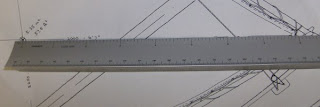BUT there are a few exciting new videos to share. First, Austrian builder Tom Puchner has posted a well-made video of his beautiful Melanesia "Velella" under sail in force 3-5 winds. Velella has admirable finish quality, and I'm especially jealous of his bamboo spars, kiato and hiking poles.
Not only is it the best Melanesia sailing vid on Youtube at the moment, it's also the first one with a decent view of the steering and sail-handling work required. The video is shot using a GoPro HD camera lashed to the outrigger pole, providing a good view of what's going on. A few particulars I'd like to point out:
- Tom's wearing a wet suit, and with good reason. The Melanesia is a very wet boat - it comes from a culture that never really had cold weather to contend with.
- He moves around a lot when sailing it. Crew weight placement matters a lot in the Melanesia.
- There's a tacking sequence that starts around 5:30 that gives an idea of how snappy these things are through the wind. Tom lifts the paddle from the water and sets it in the hull, then scoots forward to encourage the stern to slide around. He tries once or twice to complete the tack by handing the sail across to the other side, but that doesn't work, so he paddles the bow through the eye of the wind and sheets in. Elapsed time is close to a minute. The former casual monohull racer in me cringes at the idea of a tack taking longer than 15 seconds. I wonder if he'd do better with some ballast stored in the bow? I've read that can help with this problem.
- Compare all that to the jibe at around 0:55. Just point downwind, flick the sail over to the other side, disentangle one's self from the sheet, and you're done. Clearly, jibes are far easier than tacking in these, and there was no violence to the transition like you'd expect from other sail shapes.
- I wonder if it would be better to mount the mainsheet lower on the spar, and lead it to a point a little further forward, out of the ? It seems to be causing Tom some trouble.
- In a strong breeze and when the wind's on the hull side (as opposed to the outrigger side), the outrigger float ("ama") dives and throws up considerable spray. I happen to know that Tom's using a very sleek and buoyant homemade foam ama, so when you notice that happening, imagine it being much worse on a boat with a timber ama like the one I'll probably use.
Next up, another, much briefer Melanesia video from an unknown francophone builder. This one offers a few still shots of the canoe strapped to a van roof and being assembled on the beach, then cuts to some footage taken from inside the canoe while under way. The camera's POV is too close for the kinds of insights that we get from Tom's video, but there are some good views of the sail lacing and steering position, and the canoe scoots along nicely with two adults aboard.
The final video I have for you is the launching of James Wharram's latest design, the Melanesia's big sister "Amatasi." Like Melanesia, Amatasi is a design that carries strong ethnic influences. It does not use crab claw sails, but it does use the steering paddle and the general hull shape is very similar to the somewhat smaller Tahiti Wayfarer. The video doesn't really show the craft under way, but it does offer a chance to see designers James Wharram and Haneke Boon in a moment of triumph.
That's all for now. I hope to be able to bring my hull into the house for a couple work sessions after the holidays, but until then there's not likely to be much to write about in this boat building blog.







































